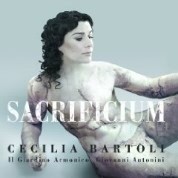If you are a fan of great, florid singing and/or Cecilia Bartoli, this remarkable set is both self-recommending and beyond criticism. It is devoted to the art of the castrato, those men who were mutilated just at or before puberty if and when their families thought (hoped?) they had enough talent to become great singers and therefore great earners. In the spectacularly-put-together booklet accompanying these two discs we learn that “hundreds of thousands” of boys were so inflicted; this is the highest estimate I’ve ever heard and I suspect it is spurious. Yes, there were thousands over the course of the 17th and 18th centuries (and even into the 19th; there are recordings extant of the last of the castrati, made in the Sistine Chapel in 1902 and 1904 that take a strong system to listen to), and very few achieved any fame at all. Nevertheless, the figure seems high. Be that as it may, it is a remarkable phenomenon–grotesque and fascinating–and that’s the point that Bartoli seems to be making with the 100-page-plus compendium of everything-you-might-always-have-wanted-to-know that accompanies the CDs. There are also pictures of the instruments used for such purposes, which bring to mind the Spanish Inquisition.
Audiences flocked to hear these singers with the lung power and volume of men and the range of women; the procedure stopped their voices from breaking while their bodies continued to grow. They were the highest-paid singers in the world, while at the same time they were reviled, mocked, and adored. Monstrous photos of Bartoli’s head on mutilated statues of men dot the pages of the accompanying booklet. We get it, we get it! As a marketing plan (said to have been Bartoli’s brainchild) it certainly is bizarre.
The music is another story entirely. Not all of it is great stuff–Porpora was no Mozart and neither was Francisco Araia–but the performance level of these showpieces raises the simply good and flashy to a level of high art and wonderment, just as it did when the castrati for whom they were written first sang them. And happy to report, Bartoli is in her best voice and not miked too closely (on her Sonnambula recording you could hear her tongue move).
The CD opens with a “simile” aria from Porpora’s Siface–in this case the singer compares himself to a storm-tossed ship–with period horns blazing, strings slashing away, and Bartoli turning out fabulous, dexterous, seemingly endless roulades at full voice, with each note perfectly articulated and equal stress given to the top, middle, and bottom of her range. If you didn’t know already, it would be hard to guess that the next piece, from Caldara’s Sedecia, is sung by the same person: Bartoli scales her voice back for this lament and spins long, threadlike lines with delicate trills and true sadness in her voice.
And so it goes–a vengeance aria from Araia’s Berenice follows, a truly berserk piece after which you’ll need a nap, with breaths so long that you suspect studio tampering or a third lung. Later Bartoli and the orchestra imitate a nightingale, and an unhappy one at that: it is clearly a piece that was composed merely to stun, since it has no way of enlightening an operatic situation (it’s by Porpora again, from Siface).
There is a long-winded piece from Germanico in Germania (oh, that Porpora) in which a lover is taking leave of his beloved; as usual it is a da capo piece–the slow expression of grief is interrupted briefly by a railing against heaven. The slow sections have a repeating refrain that is about as heartbreaking as anything you’ll ever hear, and Bartoli’s restraint is ravishing. One of the arias–“Nobil onda”–features a cadenza that is two notes short of three octaves.
Il Giardino Armonico under Giovanni Antonini is sensational at all tempos and all dynamic levels, helping to make each work the vital musical and dramatic experience it is. They batter as well as they caress, and like Bartoli, really have what the castrati were, um, missing.
The first CD is 78 minutes long, and the second, which contains “Ombra mai fu” from Handel’s Xerxes (probably the only piece you’ll recognize) and two other pieces, is another 21. I don’t recommend listening to these CDs in one sitting–there are simply too many notes and they tend to become scrambled in the ears; but overall this is a stunning undertaking in both the scholarly and musical sense. Could the castrati have sung this music better, with more accuracy, stronger bottom notes, more feeling? I suspect not. Farinelli, Caffarelli, Senesino, and the other castrati made the music famous by their dazzling performances–and let’s face it, you wouldn’t be hearing these pieces today (there are a dozen world-premiere recordings here) if it weren’t for Bartoli. One of her gifts as a performer has been that you always sense how much she loves to sing–and it’s abundantly clear here. [11/27/2009]
































